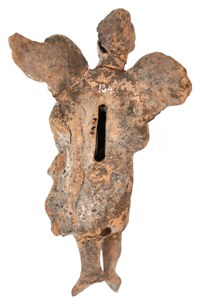Flying Eros
|
Flying Eros, Inv. T I-48 Front side out of the mould, back side cursorily worked, smoothed. Head formed roundly by means of a second mould. Narrow, highly rectangular kilning hole. No additional hanging device. Finely elutriated, hard, light red-brown (5YR 7/6) clay. Abundant white engobe on the face, wings, robe folds. Pale pink painting on the robe, legs, hair and wings. Traces of sintering. Provenance: Unknown. Probably acquired before 1907. State of preservation: Composed of many fragments. Major defect on the left side of the head. Long crack through the right side of the face. Injury at the root of the nose. Tip of left wing lost. Dimensions: H: 16,9 cm; W: 10, 4 cm; D: 5,4 cm. References: D. Graen – M. Recke (eds.), Herakles & Co. Götter und Helden im antiken Griechenland (Gießen 2010) 88 f. fig. 44. |
Description: A young male winged creature, Eros, is wrapped in a large cloth-rich cloak, which is wrapped in dense transverse folds around the upper body and arms and falls down to the knees. The neck and left shoulder are uncovered. The right hand lifts a corner of the robe from the inside, creating diagonal folds that run downwards to the left thigh. Below the supported left arm, a length of fabric cascades down. Bare stocky legs, the right in front of the left, peek out from under the coat. The tips of the feet are turned downwards. Large curved wings with finely differentiated wing feathers attach behind the shoulders.
The roundish-oval head is slightly lowered and turned to the left. On the crown the hair forms a thick plait, followed by flat, irregularly curled strands. In relation to the round cheeks, the jutting chin and the large nose, the mouth appears small. The closed lips are slightly curved. Narrow upper eyelids can be distinguished from the deep-set eyes. Above the high orbitals the eyebrows form symmetrical arches.
Commentary: Upward curved wings and feet stretched to the tips indicate Eros' flying posture. The crown plait and chubby cheeks, a large upper head and rounded legs prove his childishness, while the only gradually and slightly tapering cheek area shows that he has already outgrown early childhood[1]. There are no exact parallels. The robe and posture motif are reminiscent of a winged figure with a feminine-looking head from Myrina[2], which also represents a later age group. The light red-brown tone colour of the statuette T I-48 could also indicate its origin from Myrina, but the type speaks against it. The flying Myrinaean mantle erotes, also called "type funéraire" or grave erotes after the places where they were found in graves[3], are characterised by legs pressed tightly together and childlike round, usually lowered heads with large forehead skulls[4]. The Giessen specimen differs from these with its differentiated leg position, the detailed, plastically rounded folds and its three-dimensional layout. In this, as well as in the drapery of the mantle and the shape of the wings, it resembles the floating erotes from Boeotia (Tanagra)[5]. From early Hellenistic times, statuettes of young boys and girls in short chitons were also created there, with the strap-like sleeves sliding off their shoulders[6] in a similar way to the cloak of the Giessen Eros.
Determination: 1st half of the 3rd century BC, Boeotia?
 |
 |
 |
|---|
[1] Cf. P G. Leyenaar-Plaisier, Les terres cuites grecques et romains (Leiden 1979) no. 297 pl. 50; S. Besques, Cat. raisonné des figurines et reliefs en terre-cuite grecs, étrusques et romains III, 1 (Paris 1971) D 31 pl. 8 d; id., Figurines et reliefs grecs en terre cuite (Paris 1994) 90 fig. 79. H. Rühfel, Das Kind in der griechischen Kunst (Mainz 1984) 221 f. note 135 fig. 91. Rühfel ibid. 241 figs. 95. 102.
[2] D. Burr, Terra-Cottas from Myrina in the Museum of Fine Arts (Boston 1934) 56, no. 62, pl. 25.
[3] S. Mollard-Besques, Myrina (Paris 1963) 60-63 pls. 77-79; U. Mrogenda, Die Terrakottafiguren von Myrina (Frankfurt am Main 1996) 66 f. 125. 128-131; G. Mendel, Cat. des figurines grecques de terre cuite (Constantinople 1908) 298 f. nos. 2338-2342.
[4] Burr ibid. 47 f. no. 34-37 pl. 14; F. W. Hamdorf, Die figürlichen Terrakotten der Staatlichen Antikensammlungen München ( Lindenberg im Allgäu 2014) 411 f. fig. E 162; Mollard-Besques, Myrina ibid. 61 f. pls. 77 b. c. e. g. pls. 78 f; E. Schmidt, Kat. der antiken Terrakotten I Martin-von-Wagner-Museum Würzburg (Mainz 1994) 88-90 pls. 24 a-c; W. Schürmann, Kat. der antiken Terrakotten im Badischen Landesmuseum Karlsruhe (Göteborg 1989) 125 nos. 434. 435 pl. 76; Winter 2, 1903, 328, 1.3.5. 6-8.
[5] V. Jeammet, Tanagra (Paris 2003) 218f. figs. 151-155; I. Krieseleit – G. Zimmer (eds.), Bürgerwelten. Hellenistische Tonfiguren und Nachschöpfungen im 19, Jh. Staatliche Museen zu Berlin (Mainz 1994) no. 24; S. Besques ibid. Cat.III, 1 (Paris 1971/72) 11 pl. 9 f; A. Laumonier, Délos 23 (Paris 1956) 164 no. 503 pl. 53.
[6] Jeammet ibid. 226-229 figs. 166-170; R. Wünsche – M. Steinhart, Sammlung James Loeb I (Lindenberg im Allgäu 2009) 124 no. 57 fig. 125.

